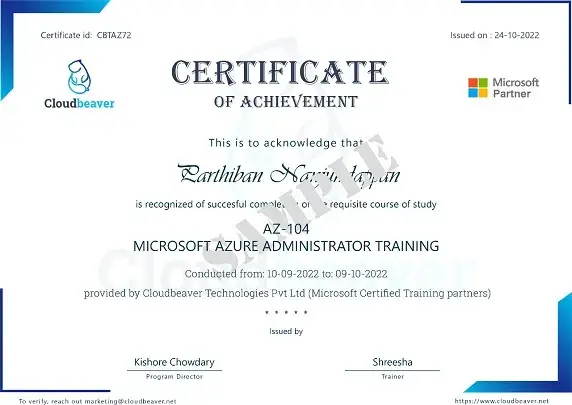AI-900: Microsoft Azure AI Fundamentals
Module 1: Introduction to AI
Artificial Intelligence in Azure
- What is Artificial Intelligence?
- Common Artificial Intelligence Workloads
- Artificial Intelligence in Microsoft Azure
Responsible AI
- Challenges and Risks with AI
- Principles of Responsible AI
Module 2: Machine Learning
Introduction to machine learning
- What is machine learning?
- Regression
- Classification
- Clustering
Azure Machine Learning
- What is Azure Machine Learning?
- Automated Machine Learning
- Azure Machine Learning designer
Module 3: Computer Vision
Computer Vision Concepts
- What is Computer Vision?
- Applications of Computer Vision
Computer Vision in Azure
- Cognitive Services
- Image Analysis with the Computer Vision Service
- Training Models with the Custom Vision Service
- Analyzing Faces with the Face Service
- Reading Text with the Computer Vision Service
- Analyzing Forms with the Form Recognizer Service
Module 4: Natural Language Processing
Introduction to Natural Language Processing
- What is Natural Language Processing?
- Natural Language Processing in Azure
Using Natural Language Processing Services
- Text Analytics
- Speech Recognition and Synthesis
- Translation
- Language Understanding
Module 5: Conversational AI
Conversational AI Concepts
- What is Conversational AI?
- Responsible AI Guidelines for Bots
Conversational AI in Azure
- QnA Maker Service
- Azure Bot Service
AI-102: Designing and Implementing a Microsoft Azure AI Solution
Module 1: Introduction to AI on Azure
Introduction to AI
- What is Artificial Intelligence?
- Data Science, Machine Learning, and AI
- AI for Software Engineers
- Considerations for Responsible AI
AI on Azure
- Azure Machine Learning
- Azure Cognitive Services
- Azure Bot Service
- Azure Cognitive Search
Module 2: Developing AI Apps with Cognitive Services
Getting Started with Cognitive Services
- Provisioning Cognitive Services Resources
- Endpoints, Keys, and Locations
- Cognitive Services REST APIs
- Cognitive Services SDKs
Using Cognitive Services for Enterprise Applications
- Considerations for Cognitive Services Security
- Monitoring Cognitive Services Activity
- Cognitive Services and Containers
Module 3: Getting Started with Natural Language Processing
Analyzing Text
- The Text Analytics Service
- Language Detection
- Key Phrase Extraction
- Sentiment Analysis
- Named Entity Recognition
Translating Text
- The Translator Service
- Detection, Translation, and Transliteration
- Translation Options
- Custom Translation
Module 4: Building Speech-Enabled Applications
Speech Recognition and Synthesis
- The Speech Service
- Speech-to-Text
- Text-to-Speech
- Audio Format and Voices
- Speech Synthesis Markup Language (SSML)
Speech Translation
- Translating Speech to Text
- Synthesizing Translations as Speech
Module 5: Creating Language Understanding Solutions
Creating a Language Understanding App
- Introduction to Language Understanding
- Language Understanding Resources in Azure
- Intents and Utterances
- Entities
- Patterns and Pattern.any() Entities
- Prebuilt Models
- Training, Testing, Publishing, and Reviewing
Publishing and Using a Language Understanding App
- Publishing Configuration Options
- Processing Predictions
- Using a Container
- Using Multiple Language Models
Using Language Understanding with Speech
- Speech and Language Understanding Integration
- Intent Recognition with the Speech SDK
Module 6: Building a QnA Solution
Creating a QnA Knowledge Base
- Introduction to QnA Maker
- QnA Maker vs Language Understanding
- Creating a Knowledge Base
- Multi-Turn Conversation
Publishing and Using a QnA Knowledge Base
- Testing and Publishing a Knowledge Base
- Client Interfaces
- Active Learning
- Creating a QnA Bot
Module 7: Conversational AI and the Azure Bot Service
Bot Basics
- Conversational AI and Bots
- Azure Bot Service and the Microsoft Bot Framework SDK
- Developing a Bot with the Bot Framework SDK
- Activity Handlers
- Dialogs
- Deploying a Bot to the Azure Bot Service
Implementing a Bot
- Bot Design Principles
- Designing Conversation Flow
- Designing for Interruptions
- Designing the User Experience
- Bot Framework Composer
Module 8: Getting Started with Computer Vision
Analyzing Images
- The Computer Vision Service
- Image Analysis
- Smart-Cropped Thumbnails
Analyzing Videos
- Video Analyzer for Media
- Custom Insights
- Video Analyzer Widgets and API
Module 9: Developing Custom Vision Solutions
Image Classification
- The Custom Vision Service
- What is Image Classification?
- Training an Image Classifier
Object Detection
- What is Object Detection?
- Training an Object Detector
- Labeling Images
Module 10: Detecting, Analyzing, and Recognizing Faces
Detecting Faces with the Computer Vision Service
- Options for Face Detection, Analysis, and Recognition
- Considerations for Face Detection and Facial Recognition
- Face Detection with the Computer Vision Service
Using the Face Service
- The Face Service
- Detected Face Identification
- Persisted Face Recognition
Module 11: Reading Text in Images and Documents
Reading text with the Computer Vision Service
- Computer Vision Options for Reading Text
- Using the OCR API
- Using the Read API
Extracting Information from Forms with the Form Recognizer service
- The Form Recognizer Service
- Prebuilt Models
- Training Custom Models without Labels (Unsupervised)
- Training Custom Models with Labels (Supervised)
- Using a Custom Model
Module 12: Creating a Knowledge Mining Solution
Implementing an Intelligent Search Solution
- Azure Cognitive Search
- Core Components of a Cognitive Search Solution
- How an Enrichment Pipeline Works
Developing Custom Skills for an Enrichment Pipeline
- Introduction to Custom Skills
- Custom Skill Interfaces
- Adding a Custom Skill to a Skillset
Creating a Knowledge Store
- What is a Knowledge Store?
- Using the Shaper Skill for Projections
- Implementing a Knowledge Store






















